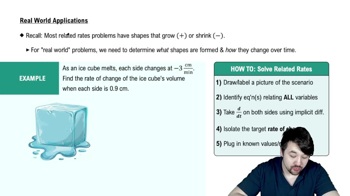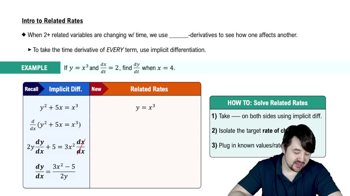Table of contents
- 0. Functions7h 52m
- Introduction to Functions16m
- Piecewise Functions10m
- Properties of Functions9m
- Common Functions1h 8m
- Transformations5m
- Combining Functions27m
- Exponent rules32m
- Exponential Functions28m
- Logarithmic Functions24m
- Properties of Logarithms34m
- Exponential & Logarithmic Equations35m
- Introduction to Trigonometric Functions38m
- Graphs of Trigonometric Functions44m
- Trigonometric Identities47m
- Inverse Trigonometric Functions48m
- 1. Limits and Continuity2h 2m
- 2. Intro to Derivatives1h 33m
- 3. Techniques of Differentiation3h 18m
- 4. Applications of Derivatives2h 38m
- 5. Graphical Applications of Derivatives6h 2m
- 6. Derivatives of Inverse, Exponential, & Logarithmic Functions2h 37m
- 7. Antiderivatives & Indefinite Integrals1h 26m
- 8. Definite Integrals3h 25m
4. Applications of Derivatives
Related Rates
Problem 3.11.45
Textbook Question
Watching an elevator An observer is 20 m above the ground floor of a large hotel atrium looking at a glass-enclosed elevator shaft that is 20 m horizontally from the observer (see figure). The angle of elevation of the elevator is the angle that the observer’s line of sight makes with the horizontal (it may be positive or negative). Assuming the elevator rises at a rate of 5 m/s, what is the rate of change of the angle of elevation when the elevator is 10 m above the ground? When the elevator is 40 m above the ground? <IMAGE>
 Verified step by step guidance
Verified step by step guidance1
Define the variables: Let h be the height of the elevator above the ground, and θ be the angle of elevation from the observer to the elevator. The observer is at a height of 20 m and 20 m horizontally from the elevator shaft.
Use the tangent function to relate the angle of elevation to the heights: tan(θ) = (h - 20) / 20. This equation expresses the angle of elevation in terms of the height of the elevator.
Differentiate both sides of the equation with respect to time t to find the relationship between the rate of change of the angle of elevation (dθ/dt) and the rate of change of the height of the elevator (dh/dt). Use the chain rule for differentiation.
Substitute the known values into the differentiated equation: When the elevator is at 10 m and 40 m above the ground, calculate the corresponding height (h) and the rate of change of height (dh/dt = 5 m/s) to find dθ/dt.
Evaluate the expression for dθ/dt at both heights (10 m and 40 m) to determine the rate of change of the angle of elevation at those specific heights.
Recommended similar problem, with video answer:
 Verified Solution
Verified SolutionThis video solution was recommended by our tutors as helpful for the problem above
Video duration:
6mPlay a video:
Was this helpful?
Related Videos
Related Practice






